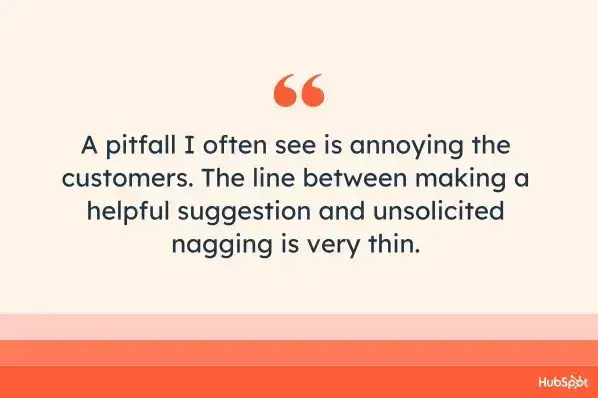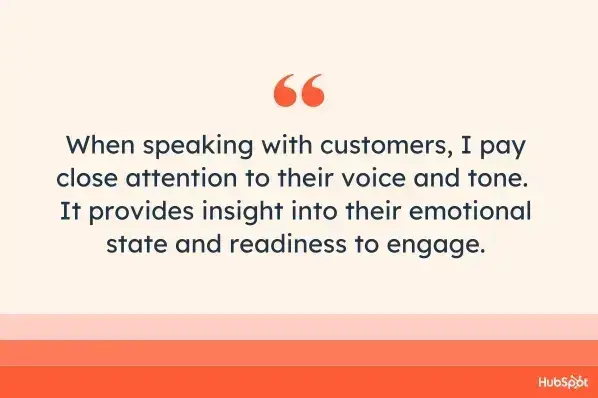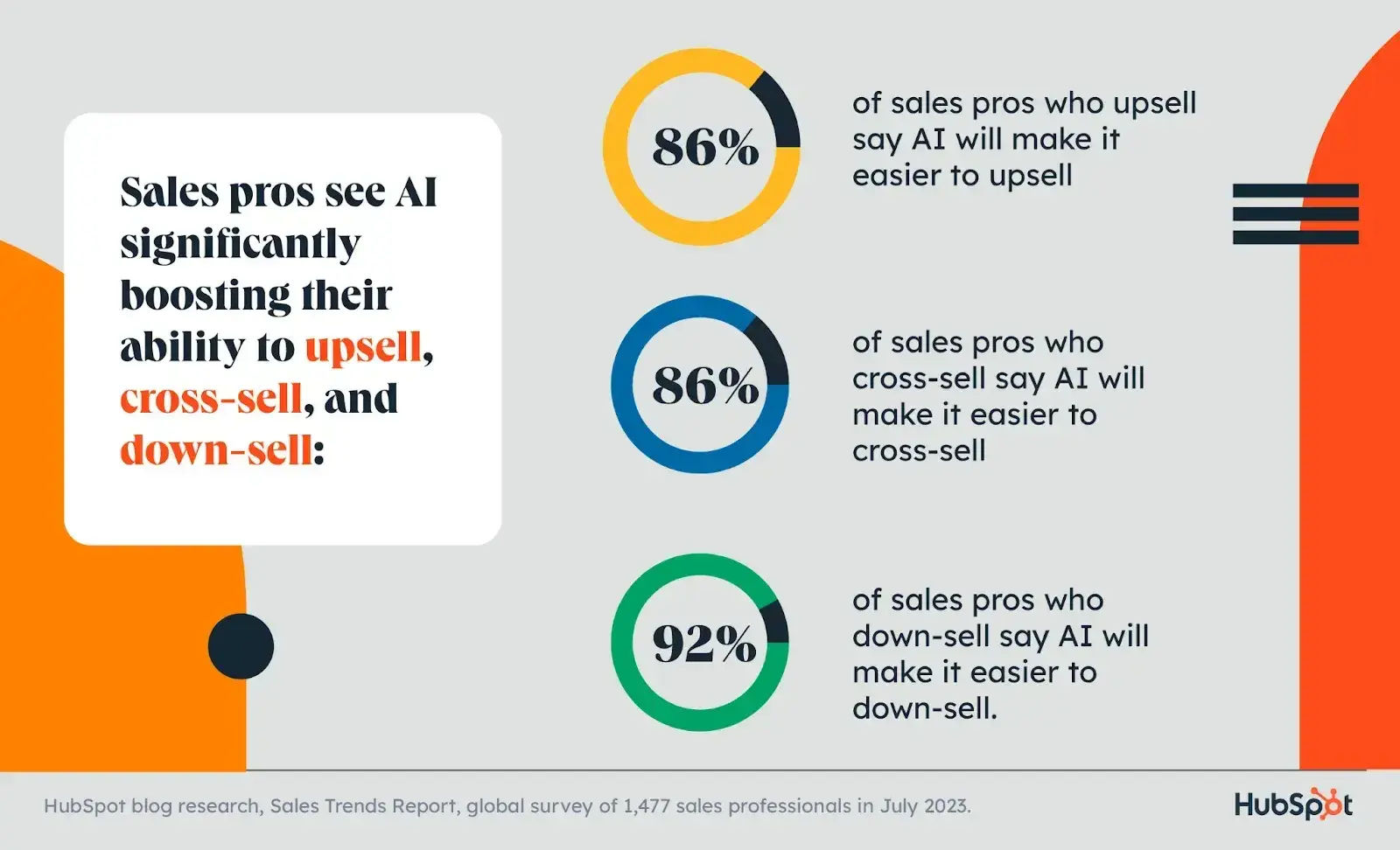In this guide, I’ll break down cross-selling as a sales tactic, highlighting how it works, its benefits, and its challenges. I’ll also share some proven cross-selling strategies you can implement today to start driving revenue growth.
In total, here’s what you’ll learn:
Table of Contents
- What is cross-selling?
- Cross-Selling vs. Upselling: What’s the difference?
- Advantages of Cross-Selling
- Disadvantages of Cross-Selling
- Preparing to Cross-Sell
- Effective Cross-Selling Strategies
- How to Cross-Sell Ethically
What is cross-selling?
Cross-selling is offering customers extra products or services that complement their original purchase. For example, imagine you work at a fast-food restaurant. A customer orders a burger. Cross-selling would involve asking the customer whether they also want fries and a drink to complete their meal. If they agree, they’ll spend more on your business.
Cross-selling opportunities are available at various points of the sales process. For example, some of my favorite places to cross-sell are product pages, checkout pages, thank you pages, and post-purchase emails.

A 2024 HubSpot survey of more than 1,400 sales professionals across North America, Europe, and Asia reveals that 87% of salespeople try to cross-sell customers and prospects during the sales process.
To start a cross-selling strategy, I first recommend identifying products that satisfy additional or complementary needs not fulfilled by the initial purchase — or that increase its value or utility. Next, encourage the customer to purchase these additional products.
Cross-Selling vs. Upselling: What’s the difference?
Cross-selling and upselling are sometimes used interchangeably, but the approaches are quite different.
While cross-selling involves offering customers additional related items, upselling involves offering them an upgraded, more expensive version of the product they selected. To upsell, you need to convince the customer that the higher-priced version is worth it.
Returning to the customer who just ordered a burger: To upsell, I’d offer options to create a more elaborate burger — adding pickles and cheese slices, let’s say — for an additional fee.

In short:
- Cross-selling adds to a sale via additional, lateral products that complement the original purchase.
- Upselling enhances the original product by offering an upgraded or feature-rich version.

Examples of Cross-Selling vs. Upselling
Here are a few realistic scenarios highlighting the difference between cross-selling and upselling.
Mobile Phone Retailer
- Cross-selling: Suggesting a screen protector, case, and travel charger when a customer buys a smartphone.
- Upselling: Offering the same phone model but with a bigger screen and longer battery life.
Web Hosting Provider
- Cross-selling: Offering domain registration and SSL certificates to customers who sign up for hosting plans.
- Upselling: Recommending a higher-tier hosting plan with more bandwidth and storage.
CRM Software
- Cross-selling: Encouraging a customer to purchase a subscription to your CRM tool after they have purchased a subscription to your marketing newsletter.
- Upselling: Suggesting a higher lever subscription to your CRM with more seats and features.
Project Management Software Provider
- Cross-selling: Proposing training workshops and consultation services to corporate clients looking to improve team productivity.
- Upselling: Suggesting an enterprise-level subscription with advanced collaboration features, better integration capabilities, and dedicated customer support.
Air Conditioning Sales
- Cross-selling: Recommending a voltage stabilizer to protect the purchased unit from unstable current surges.
- Upselling: Offering a newer model of the same unit with smart technology integration and greater energy efficiency.
Advantages of Cross-Selling
Here are the main perks of cross-selling that I’ve personally discovered.
Increased Revenue
The most direct and immediate benefit of cross-selling is an increase in sales revenue. McKinsey reports that cross-selling can increase sales and profits by 20% and 30%, respectively. Furthermore, HubSpot research found that cross-selling accounts for 21% of their organizations’ revenues, on average.
This valuable source of revenue makes sense when you look at the numbers. The typical odds of closing a sale are 60-70% with an existing customer while it’s only 5-20% with a new one.
So, encouraging customers to buy complementary products typically boosts the average order value (AOV). If your current customers are spending more, your need to constantly acquire new customers will decrease. This is also good news because it costs 5 to 25 times more to acquire a new customer than to retain a current one.
Higher Customer Lifetime Value (CLV)
One of the biggest benefits I’ve seen while cross-selling is it helps me maximize customer lifetime value (CLV), which is the total revenue generated from each customer over the course of their relationship with my business.
I’ve found that when customers perceive my business consistently meets their needs via relevant product suggestions, they’re more likely to develop loyalty and trust. This encourages more purchases over time, meaning a higher CLV — meaning more long-term revenue.
Greater Customer Satisfaction
As a sales technique, cross-selling relies on products that enhance the overall utility, enjoyment, or longevity of the primary buy. A customer who just bought their first camera from me will probably benefit additionally from a tripod and a camera bag. Having those extra products will make their overall experience more satisfying.
When I’m a customer, discovering relevant offerings via expert cross-selling is a pleasant surprise that makes me feel more understood and appreciated by the business. If there’s one thing I know, a smooth and satisfying shopping experience breeds customer loyalty.
More Product Visibility
Cross-selling involves strategically placing related products in the customer’s line of sight during their purchasing journey — products they might not have been aware of. From impulse buys to newbies experimenting, I’m able to get more attention for my offerings and more purchases this way.
Disadvantages of Cross-Selling
Like any other sales tactic, cross-selling comes with some hurdles.
Annoying Customers
A pitfall I often see is annoying the customers. The line between making a helpful suggestion and unsolicited nagging is very thin.
To avoid this, what I do is closely observe customer reactions and engagement levels during the interaction. If I sense any hesitation or disinterest, I immediately ease off the pressure.
You don’t want customers to feel like every transaction is an attempt to sell them something more. If so, they are more likely to view your business as purely profit-driven, damaging their trust in the brand and reducing the likelihood of future engagement.

Catering to “Problem Customers”
Another disadvantage is that cross-selling can ironically be less profitable, even when used successfully.
A Harvard study found that the costs of cross-selling to certain “problem customers” — such as people who frequently return products, overuse customer support, and primarily avoid regularly priced items — can actually overshadow extra revenue generated from them because these types of customers account for as much as 70% of the average company’s customer loss (which is when the cost of goods and marketing exceeds the revenue generated).
To overcome this problem, Harvard suggests thoroughly examining your business practices, identifying any that may unintentionally attract or encourage problem customers, and making adjustments.
Additionally, analyzing each customer’s transaction data can help determine whether they fall into one of the problematic categories. Depending on what I find out, I tweak my sales strategies, like upselling them instead or choosing to focus on other customers.
Preparing to Cross-Sell
Effective cross-selling begins with thorough preparation. Specifically, you must take time to learn about your customers, map out their buying journey, and know your products inside and out. Here’s how to go about it.
1. Get to know your audience.
You may already know about buyer personas. But one area I think is often overlooked is getting to know your audience after they have purchased your product. Their needs and expectations may evolve significantly after the purchase, so it’s crucial that you keep up with them if you want to do business with them again.
I recommend you create updated personas for post-purchase customers with:
- Demographic information.
- Psychographic information.
- Direct customer feedback.
Service software helps you easily deploy, manage, and gather data from customer feedback surveys. Plus, it can give you additional insights regarding your audience’s main pain points by learning how customers interact with your knowledge bases and service agents.
I’ve found that taking time to get to know my audience helps me identify not only which cross-sell products are most likely to appeal to them, but also how to communicate the offers in a way that resonates.
2. Build out your customer journeys.
The customer journey refers to the path a person is most likely to take from initial awareness of your brand to purchase and beyond.
According to Up Inc., mapping out the customer’s journey is one of the most effective cross-selling strategies, leading to increased customer retention and fewer complaints — plus higher revenue.
Cross-selling can happen at any point in the customer’s journey; it’s just easier to cross-sell at some points than others.
Mapping the customer’s journey helps me identify the sweet spots of cross-selling. For example, I find that customers are most receptive to my cross-selling pitches after they’ve seen results from my products. Plus, they’ll naturally talk to other people about it, potentially driving referrals.
3. Learn your products.
You can’t be an effective salesperson if you’re not an expert on your entire product range. Identify each offering’s respective strengths and weaknesses. How do they address specific customer needs? Most importantly, learn how different items complement one another.
If I tried cross-selling without comprehensive knowledge and understanding of my products, I’d risk suggesting combinations that don’t make sense to the customer and don’t bring any value. That would erode customer trust by leading them to believe that my primary goal is to increase sales rather than meet their needs.
In contrast, since I thoroughly understand how my products interconnect, I’m able to make informed recommendations that genuinely enhance the customer’s initial order.
4. Enhance your listening and analysis skills.
Sometimes, opportunities to cross-sell can arise unexpectedly, such as during an unrelated phone call or email exchange with a client. Therefore, another move I recommend is identifying receptive signals from customers. This involves active listening.
These are the best practices I employ when speaking with customers:
- I pay close attention to their voice and tone. It provides insight into their emotional state and readiness to engage.
- I listen to what customers don't say explicitly. Pauses, hesitations, and indirect comments can all provide clues for areas where your products or services can offer additional value or support.
- I encourage dialogue by asking customers open-ended questions instead of yes or no questions. Letting people express their needs and concerns fully allows me to see the bigger picture and to discover opportunities to serve them even better.

Effective Cross-Selling Strategies
Now that you know how to prepare for cross-selling, let’s explore a few top strategies to use once you’re ready. These are tactics I’ve personally used with tremendous success.
Personalize your cross-sale offers.
According to Forbes research, 81% of modern customers expect brands to deliver a personalized experience — with up to 70% of people expressing frustration when a company doesn’t know their history with the company.
When it comes to cross-selling, ensure that you tailor your recommendations to each customer based on their preferences, purchase history, and behavior. Just be sure not to violate customers’ data privacy.
Data analytics tools and AI have made that much easier to do. In fact, HubSpot research reveals that 86% of U.S. salespeople say leveraging AI helps them suggest the right products and services to customers at the right time.

Personalized cross-sales make your clients feel understood and appreciated by your business, which increases the likelihood of acceptance. But don’t just take my word for it.
Lisa Richards, CEO and founder of Candida Diet, tells us that sending automated, personalized product suggestions to customers (based on their initial purchases) is one of their most successful cross-selling strategies.
“Paying customers who received our personalized recommendations were 37% more likely to add at least one additional product to their basket and 25% more likely to increase their average order value,” she shares.
Richards further notes that these customers typically return to make subsequent purchases more frequently than general website visitors. The result is an impressive 12% more CLV from those who get personalized product recommendations.
Segment your customers.
I think segmenting your customers is an important step in personalizing your offers. Different selling strategies work better for different customer segments. Ryan Miller, founder and CEO of Etna Interactive, uses Sales Hub to segment his customers so he can better reach them with timely and relevant product recommendations.
Justin Mauldin from Salient PR is also a Sales Hub user and emphasizes the value of the data and analytics HubSpot provides for segmenting his customers:
“We focus on creating personalized campaigns by utilizing CRM data and setting up automated feedback loops for continuous sales insights, which help us tailor relevant offers to specific client segments, and integrating these elements provides us with a cohesive sales message.
“Our company traces patterns through HubSpot’s data-driven insights allowing us to identify high-opportunity areas and improve cross-sell strategies. This data-driven approach makes our campaigns more dynamic and impactful.”
Offer discounted add-ons.
HubSpot research from 2024 shows that 37% of U.S. sales reps who cross-sell cite offering discounts and promotions as one of their most effective cross-selling techniques.
Furthermore, 82% of online shoppers are more likely to complete a purchase if they have a discount code and coupon. Who’s surprised? Everyone loves a discount.
While I absolutely recommend you highlight the cost-saving benefit of your promotional offers or discounts, I think it’s even more important to emphasize how the add-on product enhances the customer’s experience and provides extra value.
Offer exclusive bundles and packages.
Another top cross-selling strategy is creating special packages and bundles that combine the principal product with complementary items. Often, the bundle is cheaper than ordering items separately.
One thing I like to do is position the bundle as a special offer available only to customers who buy a particular primary product. I’ve found that this often provides an extra incentive for customers to take advantage of the bundle.
Joel Popoff, CEO of Axwell Wallet, uses Sales Hub’s deal-stage automation to offer deal bundles before the transaction is completed. He asserts that the timing makes all the difference.
“For example, when a consumer adds an aluminum wallet to their cart, we don’t wait until they finish checking out,” he explains. “Instead, HubSpot sends them an email while they’re still browsing, displaying the ‘most popular bundle’ featuring our RFID-blocking cash clip. It feels like a natural decision, not an afterthought. That small change resulted in a 27% increase in AOV.”
To use this strategy effectively, I think it’s key to find the sweet spot in your bundle discount. A research study appearing in the Journal of Risk and Financial Management found that if a discount is only 20%, customers still prefer to buy individual products. If it’s 45% or higher, the preference for bundles is higher than for individual products.
Show products frequently purchased together.
Another great cross-selling strategy, particularly for ecommerce businesses, is to show products that other customers frequently buy alongside the main item.
I know when I see the “Frequently bought together” items on an Amazon page, I naturally hypothesize why it’s the case. If I determine the additional product has relevant value, I’ll probably add it to my purchase as well.
Monitor and analyze performance.
The key to keeping your cross-selling efforts sharp is to constantly monitor and analyze your performance. Personally, I track metrics like conversion rate, average order value, and customer satisfaction. Google Analytics helps me here.
Once I have that data, I analyze it to identify patterns and areas for enhancement. From there, it’s a matter of brainstorming ways to fine-tune my cross-selling tactics and optimize my offers.
Test different strategies.
Even when your current strategies are doing well, there’s room for improvement. Test different offers, messaging, placements, and bundles to see if there are more effective combinations.
Personally, I conduct A/B testing to measure the impact of variations and iterate based on my findings.
Leverage social proof.
Another cross-selling strategy I’ve found to be effective is using social proof to build confidence and trust in my offers. Display ratings, reviews, and testimonials from satisfied customers who have benefited from complementary products.
This increases the perceived quality and usefulness of the product, which will boost your customers’ willingness to accept the cross-sale. The Medill Spiegel Research Center found that displaying reviews can increase a customer’s likelihood of buying a product by up to 270%.
Train and empower your team.
Empower your sales and marketing teams with the knowledge and tools to maximize cross-selling opportunities. This includes providing comprehensive training sessions that focus on understanding customer needs, product knowledge, and effective communication.
Additionally, offer ongoing support and feedback to help your team refine their cross-selling approaches.
When I work with a sales team, I like to give them some autonomy within established guidelines. This allows them to personalize their approach to cross-selling, which I’ve found leads to more authentic interactions with customers, increasing the likelihood of success.
I spoke with two sales leaders who leverage tools in Sales Hub to empower their teams for effective cross-selling.
Fineas Tatar, co-CEO of Viva, says that using the call review feature in Sales Hub “makes it easy to listen to recordings with reps and pinpoint moments where a customer mentions a need that could align with other services we offer. We also use tracked terms to automatically find the calls where specific keywords related to cross-selling opportunities are mentioned and even automatically trigger the workflows that follow.”
He says the tool helps them catch opportunities that might otherwise fall through the cracks while training reps to be more attentive in future calls.
Leon Huang, CEO at RapidDirect, uses HubSpot’s playbooks for his team. The customized playbooks “facilitate cross-selling by turning our sales conversations into guided explorations of our client needs. We offer technically complex products, and the Sales Hub helps our team make sense and simplify so we can spot more cross-selling opportunities as they crop up.
“Instead of a rep simply taking an order for a sheet metal fabrication, for example, the playbook gives them pre-built questions to uncover their related needs. Regardless of knowledge levels, reps can ask follow-up questions like, ‘Have you considered the cost savings of using die casting for high-volume components? There’s real potential to save money here.’”
Huang appreciates Sales Hub’s playbooks because they’re interactive, allowing reps to learn rather than regurgitate templated answers. He says they’ve seen an increase in cross-sells, with a roughly 15% uplift in quotes that include multiple service lines since implementing the playbooks.
How to Cross-Sell Ethically
While cross-selling is a legitimate practice, you still need to approach it with caution. Here are a few guidelines I follow to stay within ethical boundaries.
Focus on the customer and their needs.
When cross-selling, the focus should always be on the customers and their needs. Don’t cross-sell just for the sake of it — make sure that every recommendation genuinely adds value to the customer’s purchase. Natalie Hogg, President and Head of Marketing at Method Q, says:
“If the cross-sell products/services bring additional value and enrich the customer outcomes, then it is less ‘selling’ and more ‘solving.’ The focus should be on what the customer benefits from, not what the salesperson needs to sell.”
Respect customers’ choices.
I’m sure you’ll agree with me: There’s nothing more annoying than a sales rep trying to sell you a product you’re clearly not interested in. Always respect your customers’ decisions when they decline cross-selling offers.
Whenever I’m cross-selling, I look for any verbal and nonverbal cues that indicate disinterest or discomfort. If I start a pitch but realize the customer isn’t receptive, I switch my focus to delivering excellent service and building rapport. This approach paves the way for future cross-selling opportunities based on trust and mutual respect.
Be transparent.
When taking advantage of a cross-selling opportunity, be transparent about the situational value of the product. Don’t say that a product does more than it does. If there are limitations or drawbacks associated with the additional product, mention them and offer workarounds.
As business development manager Yaz Hanley explains, being transparent about the value and costs of additional products “builds trust and helps establish a long-term relationship with the customer, which is far more valuable than a one-time sale.”
Maintain long-term engagement.
Stay in touch with your customers consistently throughout the year, not just when there’s an opportunity to cross-sell. Sienna Quirk, CMO at Invisory, explains the importance of maintaining long-term engagement:
“If your customer only hears from you during renewal season, you’ll come off as shallow and money-driven. If you continue a fairly steady beat of sharing content … you won’t seem as desperate.”
Boost Your Sales With Cross-Selling
Everyone wins when you execute cross-selling effectively. You increase your brand’s bottom line, and your customers get solutions that better address their expectations and ideals.
Sure, it requires a strategic and nuanced approach, but you have all the information needed to start. My top advice for you is: Stay in tune with how your customers feel, learn which features or products will benefit them the most, and calculate the perfect timing to introduce an extra offer.
Oh, and stay patient until your cross-selling efforts thrive.
Editor's note: This post was originally published in October 2018 and has been updated for comprehensiveness.
Sales Strategy



.png)

![7 key sales challenges to prepare for in 2026 [+ how you can overcome them]](https://53.fs1.hubspotusercontent-na1.net/hubfs/53/sales-challenges-1-20251023-788058.webp)
![How B2C sales could shift in a recession [new data]](https://53.fs1.hubspotusercontent-na1.net/hubfs/53/Recession%20sales%20strategies%20(1).png)
![22 Best Sales Strategies, Plans, & Initiatives for Success [Templates]](https://53.fs1.hubspotusercontent-na1.net/hubfs/53/Best-Sales-Strategies-1.png)
![What Is Sales? A Quick Guide [+ Examples]](https://53.fs1.hubspotusercontent-na1.net/hubfs/53/what-is-sales-1-20250411-8755735.webp)



